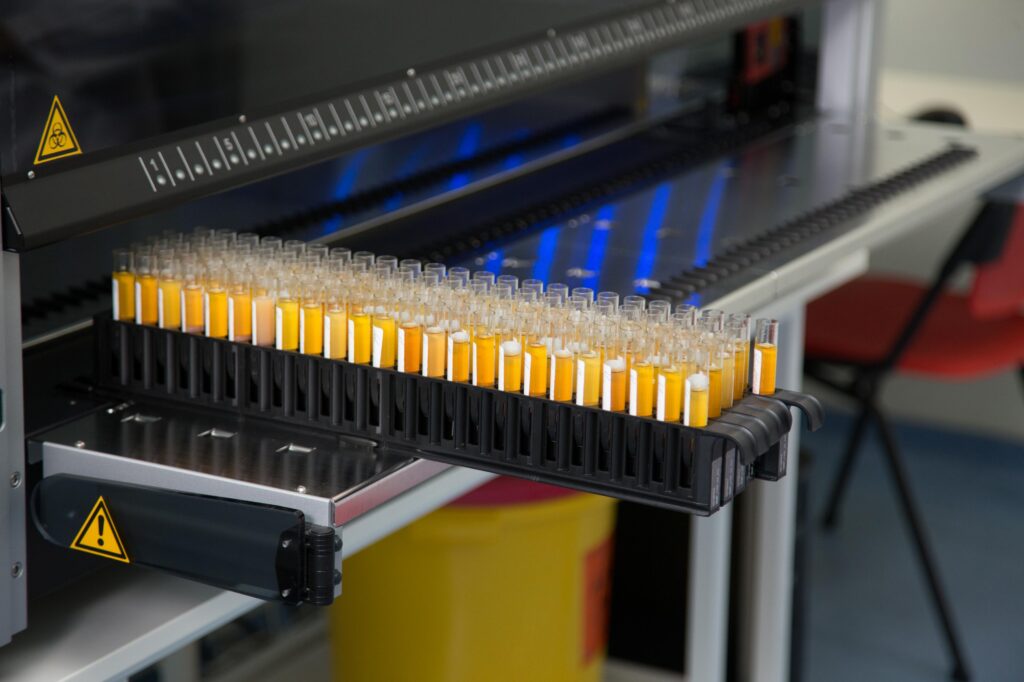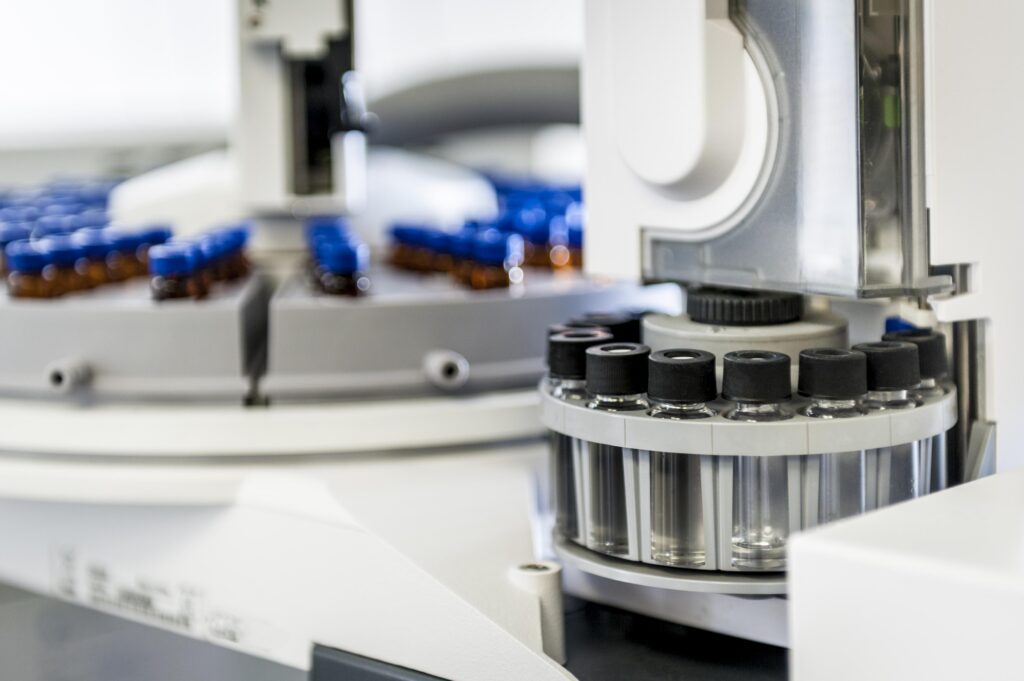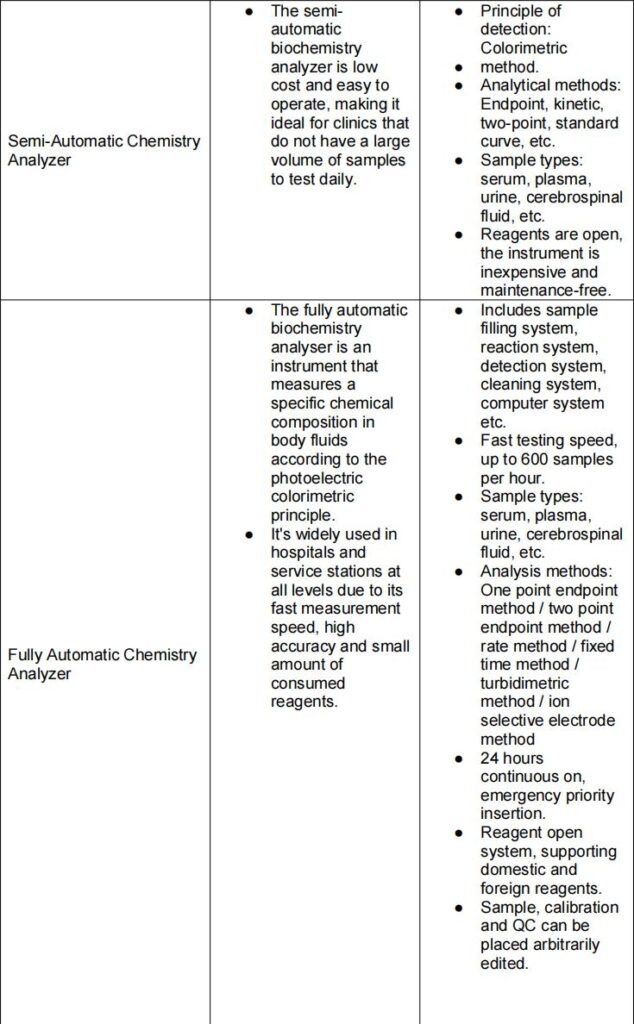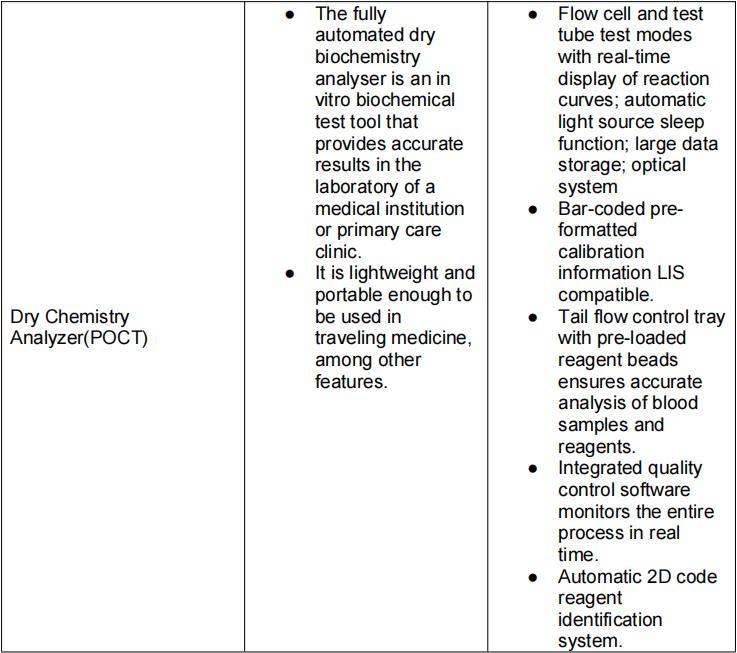Biochemistry analyzers are devices used in clinical laboratories to analyze and quantify the biochemical compounds present in various samples such as blood, urine and other body fluids.
These analyzers play a key role in modern healthcare by providing doctors and healthcare professionals with accurate and timely information about the health status of their patients. In this article we will look at the basic principles of biochemical analyzers, their types and their applications in various fields.

Principle of the Biochemistry Analyzer
The main principle of a biochemistry analyzer is to measure the amount of a specific biochemical compound in a given sample. For this purpose, biochemistry analyzers use a variety of techniques such as colourimetric, spectrophotometric and fluorometric methods. These techniques are based on the principles of light absorption, light scattering and fluorescence emission.
Colourimetry is a technique that measures the absorbance of light by coloured compounds in a sample. The intensity of the color of the sample is proportional to the concentration of the compound in the sample. The technique is commonly used to measure the concentration of glucose, creatinine and other compounds in urine.
On the other hand, spectrophotometry measures the amount of light absorbed by a sample at a specific wavelength. This technique is commonly used to measure the concentration of hemoglobin, proteins and other compounds in blood.
The amount of light absorbed by the sample is compared to the amount of light absorbed by a standard solution to determine the concentration of the compound in the sample.
Fluorimetry is a technique that measures the intensity of fluorescence emitted when a sample is exposed to a specific wavelength of light. The technique is commonly used to measure the concentration of compounds such as hormones, vitamins and drugs in blood.

Types of Biochemistry Analyzers
Biochemistry analyzers are classified into semi-automatic biochemistry analyzers, fully automatic biochemistry analyzers and fully-automatic dry biochemistry analyzers.


Functions of a Biochemistry Analyzer
Biochemistry analyzers perform a wide range of functions depending on their type and application. Some of the most common functions of a biochemistry analyzer include:
1. Identifying the presence of specific compounds
Biochemical analyzers can be used to identify the presence of specific compounds in a sample, such as drugs or metabolites. This is often used in drug development and toxicology to ensure the safety and efficacy of new drugs.
2. Quantifying the amount of a specific compound
Biochemical analyzers can be used to measure the concentration of a specific compound in a sample. This is often used in clinical diagnostics to measure the levels of specific proteins or enzymes in the blood.
3. Separating and analyzing different compounds
Chromatography systems can be used to separate and analyze different compounds in a sample. This is often used in drug development and toxicology to identify and quantify different compounds in a sample.
4. Detecting the presence of specific antibodies or antigens
ELISA is used to detect the presence of specific antibodies or antigens in a sample. This is often used in clinical diagnostics to diagnose infectious diseases such as HIV or hepatitis.
Applications of Biochemistry Analyzers
Biochemistry analyzers are used in various areas of clinical medicine, veterinary medicine and research.
In clinical medicine, biochemistry analyzers are commonly used in clinical diagnostics to measure the levels of specific proteins or enzymes in the blood. This information is used to diagnose and monitor a wide range of diseases and conditions, such as diabetes, heart disease and liver disease.
Medication is monitored and the nutritional status of patients is assessed. For example, measurements of serum creatinine and blood urea nitrogen are used to assess kidney function, while measurements of glycosylated hemoglobin are used to assess the long-term glycaemic control of diabetic patients.
They are also used in drug development to identify and quantify the different compounds in a sample. This information is used to ensure the safety and efficacy of new drugs and to develop new drugs for specific compounds. It also enables drug therapy to be monitored and the nutritional status of patients to be assessed.
For example, serum creatinine and blood urea nitrogen measurements are used to assess kidney function, while glycosylated hemoglobin measurements are used to assess long-term glycaemic control in diabetic patients.
In veterinary medicine, biochemical analyzers are used to diagnose and monitor diseases in animals. They are used to measure the levels of various biochemical compounds in the blood, urine and other body fluids of animals. This data is used to assess the health of the animal, diagnose disease and monitor the effectiveness of treatment.
How do I Maintain My Biochemistry Analyzer?
- The pump tube should be removed from the pump wheel when the fully automatic biochemical analyzer is not used for a long period of time. Extend the life of the colorimetric cell and reduce cross contamination. The colourimetric cell and liquid channels should be flushed at the end of each day’s work.
- It can be cleaned with sodium chlorate cleaning solution, and then rinsed with distilled water. Note that when cleaning with distilled water, loosen the suction switch and remove the tube action should be well coordinated. Not only should the distilled water in the suction tube be emptied, but also keep the colorimetric pool still full of distilled water. If the biochemical analyser is not used for a long time, the liquid path should be emptied completely.
- Automatic biochemical analyzers frequently run for a long time, the instrument components may or wear, there is a hidden danger of failure. For example, the filter, after a period of use, its light transmission rate will decline. When the light transmission rate decreases to the extent that the biochemical analyzer cannot work normally, or when the instrument’s light source lamp fails. The analyzer will also automatically give an indication. In this case, the upper cover of the instrument can be opened for inspection.
- If the lamp is determined to be damaged, it should be replaced with a tungsten halogen lamp of the same type; if the power supply is faulty, it should be repaired by a professional. Another example is the pump tube. After a period of use, the pump tube can become deformed or even break and leak due to prolonged squeezing. If it has been significantly deformed, this can lead to inaccurate suction volumes. In addition, the fuse tube is also prone to failure. When a fuse is blown, always cut off the power before replacing it with a fuse of the same size. Or replace it under the guidance of a professional.
WHY CHOOSE US?
Our mission is to integrate high-quality medical resources, solve customer procurement problems, and beautify the industry market environment. Kaihong has been manufacturing high-quality medical device products for more than ten years.
We have built our reputation on delivering quality healthcare solutions on time and on budget. All our products comply with international health and safety regulations and all products come with a warranty.
Are you still worrying about your customer’s product needs? If you’re tired of not getting the value for your money, we’ve got your back! Our urine analyzers have various models and support personalized product customization.
A TASTE OF VARIETY
Our company has many styles to choose from. In addition, we have high-quality pre-sales consulting guidance and professional after-sales service, all to meet your needs.
Whether it is a cost-effective or high-end product, there will always be something suitable for you on our end. If you have any needs for products, you can ask us, our factory will meet your needs as soon as possible, and we will make every effort to provide you with solutions.Feel free to send us your inquiries.
